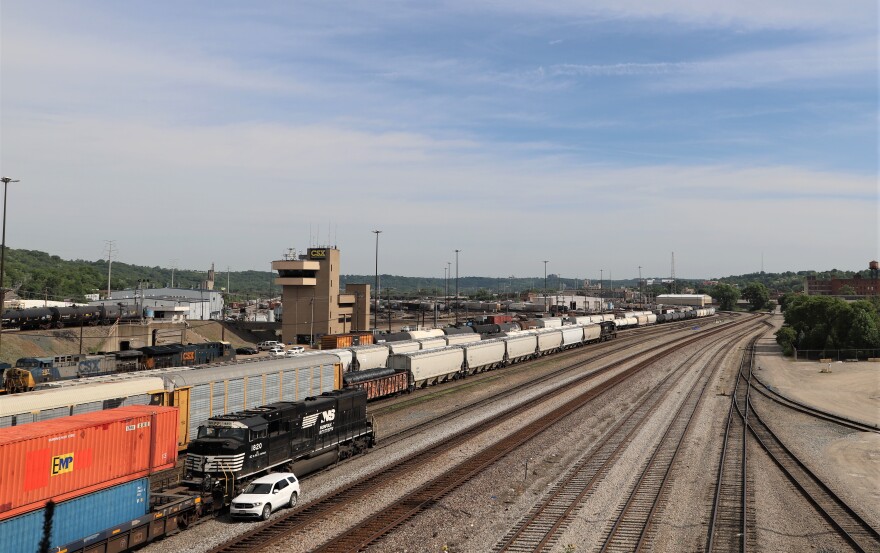We're back in Camp Washington for WVXU's Round the Corner series, where we're reporting on the neighborhood's mysterious — and beloved — train noises.
There's a high, elusive sound you'll hear sometimes from the Mill Creek Valley. It echoes for miles through Cincinnati's hillsides, into Mount Auburn and Price Hill. You'll catch it for a few seconds — silvery, otherworldly. Then it's gone again.
One of Camp Washington's less tangible exports is the sound of trains from all across the country gliding around tracks that follow an ancient bend in the Mill Creek.
It's endeared itself to many who live in the neighborhood and captured the imagination of multiple artists. You might have heard the sound called "whale calls" and other nicknames. You could also think of it as Camp Washington's industrial spirit made audible.
Roy Hord is a member of the Cincinnati Railroad Club. He's been studying trains for six decades. He has an encyclopedic knowledge of the Queensgate Yard, which includes the CSX rail hub on Camp Washington's western edge, where the sound originates. The sprawling yard we know today was built in 1981 as railroads consolidated. But Hord says the neighborhood's history with railroads runs much deeper.
"There have been railroad yards in the Mill Creek Valley since the 1850s," he says. "There were seven major railroads in Cincinnati in the 20th century. They merged, and now there are only two (CSX and Norfolk Southern). So Queensgate Yard came about in the 1980s to replace more than a dozen other yards that were spread out in the Greater Cincinnati area and Northern Kentucky."
RELATED: Sale of Cincinnati's railway back on track for voters to consider
Queensgate Yard includes maintenance facilities and a classification hub — where train cars are sorted and chained together to get to their final destination. Hord says it's a very important part of the national rail freight system.
"Queensgate is significant, especially to CSX, because there are so many lines that come into Cincinnati," he says. "They come in from Washington, D.C., St. Louis, Louisville, Atlanta, Chattanooga. And then from the north, there's a major line that comes down from Detroit. That's why there's so much automobile traffic. Detroit, Toledo, Chicago, Cleveland, New York. All those lines come into Queensgate."
But where does that mysterious sound come from? Hord has an answer.
"Basically, they either call it 'flange squeal' or 'wheel squeal,' " he says. "When the steel wheels of the cars go around a fairly sharp curve, it sets up a vibration, and when that vibration reaches a certain frequency, it becomes sound. One way to explain it is, when you take a wine glass and wet your finger and run it around the rim, eventually you're going to reach a point where it starts to make a sound. That's quite a bit like what's happening."

Hord explains that most curves on rail lines are very gradual, taking place over thousands of feet. But curves in the Queensgate Yard are cramped and can take place in 1,000 feet or less — sharp enough to produce the vibration you hear ringing across Cincinnati's hills sometimes. As the rails follow the bend in the Mill Creek, the sound arises.
"Down at Queensgate — especially in that Hopple Street area — the whole yard is kind of making a turn there, so you'll hear that a lot," he says.
'It sounds like home'
As unusual and sharp as it can be, many residents in Camp Washington say they actually love the sound.
Artist and author Jenn Howd recently worked on a project involving neighborhood sounds for a creative space in Camp Washington called The Well. Howd asked people in Camp Washington and Pleasant Ridge about their favorite sounds, then composed music around the ideas. She says one sound in particular kept coming up in Camp Washington.
"Quite a few folks in the neighborhood chose the sounds of the trains as their favorite sound," she says. "Many told us about how the train sounds are so unique to the neighborhood, and several of them spoke about how they find the sound to actually be quite comforting, which I found to be really interesting."
Artist, author and cultural geographer Omope Carter Daboiku is very familiar with Camp Washington and collaborated with composer Nate May and others on another project at The Well exploring the relationship between sound and Appalachian, Indigenous and African American communities.
RELATED: Camp Washington's art community is weird, wild and growing
Daboiku grew up around trains in Ironton, Ohio, and spent a number of years living near Queensgate Yard starting in 1972. She says the sound of the trains in Camp Washington remind her of the sounds of her childhood.
"On a clear day, I could see some of the railyard," she says. "I would go to sleep every night with the bang, clack, boom, squeal. It was soothing for me."
But there's something forlorn about those sounds today when you consider industry's legacy of pollution and the loss of jobs in the neighborhood, she says.
"With the decreased rail transportation, that's a lot of empty toxic land," Daboiku says. "And it makes it feel like it's deserted, when at one time it was quite vibrant. It changes the whole nature of the soundscape of the neighborhood. It sounded different down in there when they were baking bread and brewing beer and slaughtering pigs and cows."
Many who live in Camp Washington still find it comforting. Both Howd and Daboiku compare the sound to church bells — a way to mark time, affirm a community identity and know you're in a familiar place.
"Perhaps that's what makes the sounds of the Camp Washington trains so consoling to neighborhood residents," Howd says. "Because they know on a conscious or subconscious level that they're close to home whenever they hear them."



